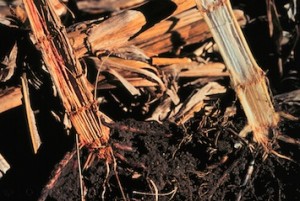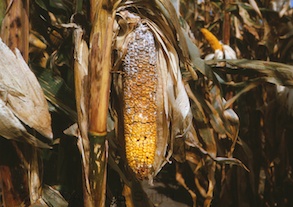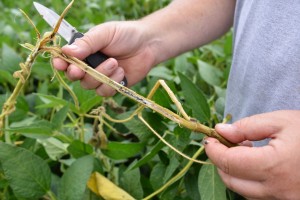What Should You Know about Corn and Soybean Diseases as You Prepare for Harvest?
Damon L. Smith – Extension Field Crops Pathologist, University of Wisconsin
As the fall is approaching and crop harvest plans are being made, it is important to continue to assess disease issues in corn and soybean. These assessments aren’t being made in order to make plans for in-field management, but to improve the quality of grain that is harvested and allow for some educated decision-making for 2016.
Some Diseases to Consider in Corn at Harvest

Figure 1. Gibberella stalk rot on corn. Severe stalk rot on the left and less severe stalk rot on the right.
Now is the best time to begin scouting corn for stalk rot issues and also fungal ear rot potential. Diseases such as Anthracnose stalk rot and Gibberella stalk rot are becoming apparent in corn. Inspect the stalks integrity on the outside. Be sure to squeeze the outside of the stalk to gauge the potential severity of the rot on the inside of the stalk. Cut a few stalks from diverse areas of the field to see how rotted stalks might be. In figure 1, the stalk on the left has a severe case of Gibberella stalk rot, while the stalk on the right is far less rotted. Fields that had high levels of norther corn leaf blight (NCLB) this season, are going to be more prone to stalk rot due to the added stress of the foliar disease. The more severely rotted stalks are, the more likely they will lodge. Therefore timely harvest is important. Growers should target harvesting of fields with severe stalk rot before fields that have less stalk rot, in order to minimize harvest losses due to lodging.
Ear rots can also be an issue at harvest time. Fusarium ear rot, Gibberella ear rot, and Diplodia ear rot (Fig. 2) are just a few that can damage corn in Wisconsin. It will be critical to check fields in the next several weeks in order to make decisions on what fields to harvest first. Harvest priority should be placed on fields with a high level of ear rot. As corn stands late into the fall, certain ear rot fungi can continue to grow, damage ears, and cause increases in mycotoxins in grain. The quicker these fields dry and can be harvested, the more likely the losses due to ear rot and mycotoxin accumulation can be minimized.
Soybean White Mold Management at Harvest
In Wisconsin, the main disease to consider when making harvest plans in soybean is white mold. White mold is present in some soybean fields in the state and has caused considerable damage in a few of those fields. Remember that the white mold fungus not only causes stem blight and damage, but also causes the formation of sclerotia (fungal survival structures that look like rat droppings) on and in soybean stems (Fig. 3). These scelrotia serve as the primary source of fungal inoculum for the next soybean crop. They also get caught in combines during harvest. These sclerotia can then be spread in combines to other fields that might not be infested with the white mold fungus. Therefore, it is important to harvest non-infested soybean fields first, followed by white mold-infested fields, to be sure the combine does not deposit any residual sclerotia in the non-infested fields. If this is not an option and you must harvest white mold infested fields before non-infested fields, be sure to clean the combine thoroughly between fields.
For more information about white mold management in soybean you can click here and scroll down to “white mold” or watch a video by clicking here.
Identify Corn and Soybean Diseases Now to Make Decisions for 2016
While most of the focus during this time of season is on equipment and calibrating yield monitors, it is important to get an accurate diagnosis on any soybean and corn diseases you are seeing now. This information will help this winter as you review variety and hybrid trials and make decisions about what you are going to plant in 2016. Have knowledge of the primary disease issues in your fields. This will allow you to choose varieties and hybrids with the best disease resistance package to combat those diseases. Finally, now is a great time to sample for soybean cyst nematode (SCN). For more information on sampling for SCN in Wisconsin, CLICK HERE.




